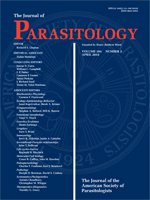V. V. Tkach, J. M. Kinsella, S. E. Greiman
Journal of Parasitology 104 (2), 157-167, (1 April 2018) https://doi.org/10.1645/17-151
Two new species of Staphylocystoides are described from masked shrews Sorex cinereus. Staphylocystoides oligospinosus n. sp. was collected from the vicinity of Missoula, Montana, United States, and Staphylocystoides parasphenomorphus n. sp. was collected from the vicinity of Whitehorse, Yukon Territory, Canada. Morphological differentiation from known species is provided. Both species are morphologically closest to Staphylocystoides sphenomorphus and to each other. Among other characters, S. oligospinosus n. sp. can be easily differentiated from all known species of the genus by unique cirrus armature, which consists of a short zone of small spines at the base of the cirrus, a few large sparsely distributed spines of varying size in the middle part of the cirrus, and hair-like microtriches densely covering the apical portion of the cirrus. Staphylocystoides parasphenomorphus n. sp. differs from S. oligospinosus n. sp. in a number of characters, most distinctly in cirrus armature, and from another morphologically similar species, S. sphenomorphus, in the number of proglottids, strobila size, number and size of rostellar hooks, and relative length of cirrus sac. Comparison of partial sequences of nuclear large ribosomal RNA subunit gene (1,310 base pairs [bp]) and mitochondrial NAD(P)H dehydrogenase subunit 1 gene (710 bp) strongly supports the status of the described forms as new species. This increases the number of Staphylocystoides species known in North America to 9 (5 parasitizing S. cinereus) and the total number of species in the genus to 12. Staphylocystoides parasphenomorphus n. sp. is the first named Staphylocystoides record in Canada.

